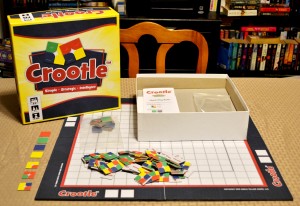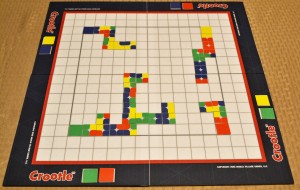“Crootle” was one of the unfortunate games to not meet its Kickstarter goal back in September of 2013. That, of course, isn’t stopping the developers from trying again. After listening to feedback from their supporters and implementing a few changes, “Crootle” is back on the charts. There’s still some question as to whether or not the developer will seek the Kickstarter option, but it’s good to know that they haven’t given up. What’s new, you ask, and why should you support “Crootle” this time around? Before we answer those questions, I’d like to thank Bruce over at World Village Games, LLC for providing me with an updated prototype copy. As with most prototypes, it’s important to stress that they usually aren’t representative of the final product. The content in the pictures featured below are therefore subject to change.
Firstly, let’s talk about the components. The prototype copy I received back in August of 2013 was a much smaller, more portable version. That version of the game came in a clear, plastic, rectangular case. There was also no board to speak of, though there was a long strip of paper that acted as a ruler to help folks figure out the dimensions of the imaginary board on the table. The original preview and videos I published can be seen HERE, in case you’re curious and want more information about the previous prototype. While the family and I had fun playing the game, I did notice the absence of an actual playing board.
This newer prototype copy rectified that situation and did indeed come equipped with a board, consisting mostly of a 16 by 16 playing grid. The perimeter of the board has two larger, empty spaces per side that allow players to place the corner tiles that they’ll receive at the game’s start. The tiles themselves weren’t much different in that they still consisted of four different colors: red, blue, yellow, and green. Corner tiles are of one solid color, while color tiles can be a combination of any of the four. That begs the question, is “Crootle” the same game as it was a few months ago? Yes and no.
There are actually two different rule sets this time around: beginner and advanced. The beginner rule set is very similar to one featured in the preview I linked above. Players will receive to two corner pieces of two different colors and attempt to connect said corner tiles on the board with color tiles. If Player One is given a green and red corner tile for example, then they’ll attempt to connect the green corner and the red corner on the board with color tiles. Color tile placement is still the same in that you’ll need to match the colors appropriately…red to red, green/blue to green/blue, etc. I won’t delve too deeply into this here, mainly because I covered this rule set at length in my prior article. I will note however that there is a bolded inner square that players can observe as their playing grid, the main purpose of which is to simply provide players with a quicker game.
The advanced rule set is a whole new ballgame in that in addition to trying to connect two corners to win, players will need to reach one hundred points. To do this, players will need to play multiple games/rounds until one person manages to reach the point requirement. Game setup is still the same in that each player gets to color tiles of different colors at random, with the four different colored corner tiles being placed randomly on the board as well. The differences? For starters, player turns are timed (1.5 to 2 minutes per turn). Also, creating a 4-square grants the player two additional tiles. Finally, before you start of your turn, you may swap out a corner tile with one of a different color (this is done randomly and must be a color you’re not currently using). Doing this however will cost you twenty points and you’re limited to doing this once per round.
When someone connects their two corners, the round ends and they score. Their score is equal to the number of tiles in that path (shortest route) plus two points for every four square in that path plus one point for every tile in their opponents’ hands minus one point for every tile in their own hand. The score is recorded on a separate piece of paper and whoever reaches one hundred points first, wins the game! There’s a bit more that I didn’t mention, but this should give you the highlights as to what makes up the advanced version.
So, what’s the final verdict? Does this version of “Crootle” exceed its original parameters? I’d have to say yes, for a number of reasons. For one, I’m a very visual person. When I’m helping my son with his math homework for example, I actually need to SEE the problem in order to proceed with the lesson. Having an actual board, I feel, went a long way into helping me visually organize the game while it was being played. The kids no longer played outside of the grid as they tended to do with the original prototype. Having both a beginner and advanced rule set also ups the appeal in my book, mainly because either can be observed on a whim to appease a particular audience or age group.
I praised the game for its strategic value in my original preview and I’m pleased to say that nothing changed in that regard. The game is still intense as ever, especially if you have a few people who are shooting for the same corners at the same time. While you’ll want to connect your corners to score, this game forces you to play it smart and consider what everyone else is doing at the time. After all, expanding your own path in a particular direction just might be what your opponents want in order to swoop in and make the kill at the last second. “Crootle”, as a whole, is fun, easy to play, and family-friendly. For that, it definitely deserves a second chance.
—
As of 1/24/14, the developers may seek funding through the Kickstarter process or possibly go another route. In the meantime, you can learn more about and support the game by visiting the following websites:
https://www.facebook.com/pages/Crootle-Simple-Strategic-Intelligent/372239696238762
—


